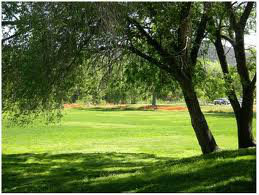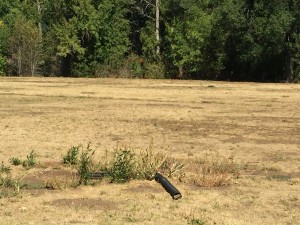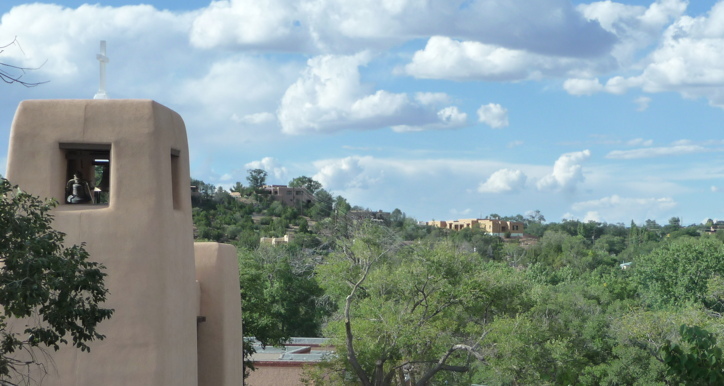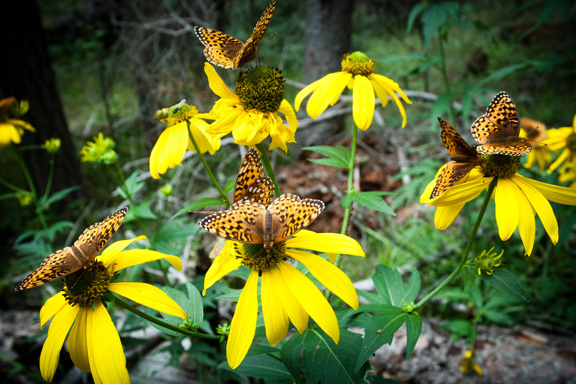-
Recent Posts
-
Standing Features
-
September 2010
-
July-August 2010
-
June 2010
-
May 2010
-
The original Review
Dispatches from the Land and Water Wars, September 2004 to October 2009
A Stroll Along Shirley MacLaine Boulevard, January 2004 to March 2004
-
Past issues
-
Masthead
The Santa Fe Review
George Johnson
P.O. Box 1442
Santa Fe, NM 87504
Along Cerrillos Road
Saturday, October 31, 2015
Before and After
Thursday, October 1, 2015
I was glad to read in this morning’s New Mexican that the District 2 councilors, Joseph Maestas and Peter Ives, are holding the city’s feet to the fire in the matter of Monsignor Patrick Smith Park.
Earlier this year, the Council passed a resolution blocking the use of park improvement bond proceeds to pay the salaries of city workers. (For background see the report in Sunday’s New Mexican.) The Parks Department says that contributed to the delays that led to the loss of five acres of grass.
Mr. Ives is not buying the excuse.
I realize that this resolution was passed saying, ‘Don’t use city workers,’ but if you’re faced with that versus allowing a park to essentially be turned into a dirt lot, I think we’re making some very wrong decisions. I’m looking for real leadership within the city on project management, and I’m not feeling comfortable with it.
The pictures below (the one on the left is from the City of Santa Fe website) show the park before and after its demise.
George Johnson
The Santa Fe Review
The Destruction of Patrick Smith Park
Sunday, September 27, 2015

In an excellent report in today’s New Mexican, Chris Quintana describes how what was once a gem of Santa Fe’s historic Alameda has been ruined by the city’s neglect:
. . . Monsignor Patrick Smith Park has always been one of the city’s more lush parks. Tucked between Canyon Road and East Alameda Street, the 5-acre property is hemmed by stately cottonwoods running along the Santa Fe River. But today, even after one of the wettest summers the city has seen in years, the park’s grass has withered into a brownish yellow husk that crunches under foot . . . The only plants that grow reliably are weeds. Goatheads abound, and gophers have invaded.
We’re supposed to accept, from the city’s convoluted excuses, that all of this was unavoidable. The irrigation system, you see, just broke — suddenly, completely, catastrophically beyond repair. And there was nothing anyone could do but sit back and watch as, over the coming years, a five-acre oasis of beautiful grass was left to die.
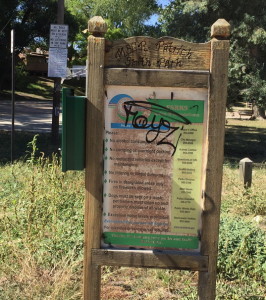 And then they were unable to fight the ensuing invasion of weeds and gophers. They were unable to bring in water trucks to keep the turf alive until the sprinklers were fixed. Stuff just happened. And now, as the costs of fixing the mess have escalated, officials don’t quite know how they will pay for it.
And then they were unable to fight the ensuing invasion of weeds and gophers. They were unable to bring in water trucks to keep the turf alive until the sprinklers were fixed. Stuff just happened. And now, as the costs of fixing the mess have escalated, officials don’t quite know how they will pay for it.
In a city where water conservation is paramount, providing a few green public spaces is especially important. Patrick Smith Park was once one of the best.
What makes this situation even harder to excuse is that the money was already available, as part of a multimillion dollar bond project that voters approved in 2012 to pay for park maintenance throughout Santa Fe. Of those funds, $140,000 was supposed to go to fix the irrigation system and for other work in Patrick Smith Park.
Mr. Quintana, the New Mexican reporter, goes on to show how the death of the park and the neglect of many others is tied to the deepening scandal over the mismanagement of the bond issue. Be sure to read his piece for the troubling details.
Meanwhile, in its meandering way, the city says it is finally addressing the problem. But first, for some reason, there had to be an archeological survey — to replace an irrigation system that was already there. It took an entire year, the New Mexican reports, to find a company that would do it for a bargain price. Then the city solicited bids for a contractor to fix the sprinklers but the estimates all exceeded $67,000, which is more than was allocated by the parks bond. So that means juggling funds, we’re told, which will take yet more time.
This morning I walked down to this depressing wasteland, through the narrow passageway from Canyon Road, the walls covered as usual by spray-painted graffiti. There were more graffiti tags on park signs and a basket ball backboard. Trash cans were overflowing and there were beer cans scattered on the ground.
Rob Carter, the new Parks Department director who inherited this fiasco, told the New Mexican that the park is his “number one priority” and that work will begin next spring. That is good to hear but it is hard to be optimistic. If the city tries to do this on the cheap, the millions of weed seeds sown over the past few years will quickly spring back and crowd out the new grass. I hope that our city councilors and the citizens of the Parks and Recreation Advisory Commission will be watching closely to make sure Patrick Smith Park gets the quality of work it deserves.
George Johnson
The Santa Fe Review
On the Blight Called Las Colinas
Tuesday, March 3, 2015

Like a scab on the northern horizon of Santa Fe’s historic district, the luxury condominium complex called Las Colinas has only gotten bigger and uglier since last reported here, a monument to those whose only interest in this town is to milk it for everything it’s worth. A ridge top where only trees and sky once appeared has been defaced forever — or at least for the century or so it will take for the buildings to decompose.
Is anyone really going to buy these things? The Eastside is now glutted with condo projects, happily approved by City Council. All are now competing for buyers who may not exist — two new developments on East Alameda and two on Canyon Road, including the project under way at the old Manderfield School.
What will happen if the buyers don’t come? Does the City have a plan in place to seize abandoned projects and convert them, perhaps, to subsidized housing for teachers or police officers? They would be far more welcome than the likely buyers of the blight called Las Colinas — people who come here because it is fashionable. People who don’t vote in our elections. People whose charity, if they are charitable, goes to the Opera and other entertainment for the rich.
Las Colinas is apparently nearing completion. Last night it was lit up like a jack-o’-lantern haunting what had been a beautiful dark emptiness.
George Johnson
The Santa Fe Review
Lorn Tryk’s Enchanted Green Village
Sunday, August 31, 2014
For the last few weeks, an obtrusive new structure has been sprawling, foot by foot, along a verdant ridge top visible from the Eastside Historic District. Several days ago I walked up Gonzales Road, a little past Cerro Gordo, and there it was: a multi-unit complex of 14 luxury residences called Las Colinas. The architect is Lorn Tryk, who (as a principal of Lloyd & Tryk) brought us Eldorado Hotel. The names of the other developers are hidden, as so often is the case, behind an LLC: Piedra Partners.
. . .stunning views, modern pueblo design with fabulous high end finishes all in a once in a lifetime location. . . . an enchanted East-Side location. . . . will incorporate the highest design and Green Build standards within a thoughtful village setting.
An enchanted emerald village. I guess there are people who make a living writing this stuff.
Go to the website and behold the majestic view of the mountains available to buyers. Of course there is no photograph of the view that the development will despoil.
We like to think that we have strict ordinances in Santa Fe to protect the hilltops. But as far as I can tell, this project was approved without the slightest controversy. The hearing by the Historic Design Review Board apparently received no coverage by the local newspapers. An engineer at the city Land Use department tells me that all permits were secured, and she assured me that the developer will be required to screen the blight (my word not hers) with trees. But it is hard to be optimistic considering what has happened to so much of Santa Fe’s eastern hills.
“Las Colinas” means “the hills.” In all the time I’ve lived in Santa Fe colina is a word I hadn’t run across. There are cerro and loma, but they were already taken by other developments. Maybe there is a computer program that spits out Santa Fe style names.
The Attack of the Citizen Scientists
Monday, July 30, 2012
Earlier this week I spent three days in Aspen, Colorado, at a small meeting on how to improve science literacy. First you have to define what that means, and David Pines, the physicist who organized the event, suggested that it was not simply a matter of knowing a lot of stuff. You can be scientifically literate and not necessarily be able to describe Maxwell’s equations or name the columns in the Periodic Table or the six flavors of quarks. But what you do need is a solid grasp on how science works: Things are discovered by posing questions about the world and then seeking answers through precise observations and experiments.
It is a long, difficult process. But over the years as thousands of scientists collaborate and compete, a consensus will emerge: Life on earth evolved and changed through random variation and selection. The universe began with a big bang and is continuously expanding. The knowledge will never be complete, and sometimes an anomaly will arise — a scrap of data that doesn’t fit into the big picture. If enough of these accumulate, an area of science might undergo a paradigm shift. The sun, not the earth is the center of things. Andromeda is not a small, nearby cloud of light but a galaxy far, far away. More often the anomaly will turn out to be wrong. If not the theory will be modified. It is through this give and take that knowledge emerges.
Participants at the Aspen meeting were flabbergasted when I told them that the Santa Fe City Council, acting on the testimony of a few citizen scientists whose only qualification was an Internet connection, had decided to stop fluoridating the water supply. The vote has since been rescinded. But when the hearing on the issue comes around in August, the loudest voices will arise from those who know the least.
None of these people would consider themselves scientifically illiterate. They have filled their heads with a lot of stuff. Starting with what they already were convinced was true, they ventured into cyberspace to pick and choose the evidence that suited them. Or more likely they found an advocacy group, the Fluoride Action Network, that had already done the choosing for them. But they miss or choose to ignore the dynamic through which real science unfolds.
A study I mentioned earlier, When Public Action Undermines Public Health: A Critical Examination of Antifluoridationist Literature, describes the phenomenon:
Although the overwhelming majority of scientific enquiry supports the benefits of water fluoridation, members of the public who type the term “water fluoridation” into any of the major search engines would immediately be presented with a disproportionate percentage of anti-fluoridation websites.
The information ranges, the authors note, “from factual, to unsubstantiated opinion, to outright fraud.”
As they go about their “research,” what the citizen scientists won’t find is a single definitive study — where, let’s say, identical twins were taken from their mothers at birth and raised with and without 0.7 milligrams of fluoride in their drinking water and with all other variables — number of candy bars eaten, frequency of brushing teeth — carefully controlled and accounted for. Instead beginning in the 1940s there is one imperfect study after another. Each was conducted differently and each has its own strengths and weaknesses. That is the nature of epidemiology.
But taken together the accumulation of evidence has persuaded the American Public Health Association to strongly recommend “the fluoridation of all community water systems as a safe and effective public health measure for the prevention of tooth decay.” The group’s paper, Community Water Fluoridation in the United States, describes its reasoning and cites the supporting studies. A Systematic Review of the Efficacy and Safety of Fluoridation, a long study by the Australian Government’s National Health and Medical Research Council, reaches a similar conclusion.
Next month’s hearing will be filled with testimony from people who believe that they have found the smoking gun — some study, ignored or suppressed, that threatens to topple the scientific consensus. I’ll examine the evidence they are likely to present in a future dispatch. But the important point is that there is an expert body of opinion on water fluoridation. As they decide whether or not to overturn a longstanding public health policy, our counselors — those which are scientifically literate — will have to take that into account.
George Johnson
The Santa Fe Review

Fluoride, Part 2
Thursday, July 26, 2012
The City Council has rescinded its vote to stop fluoridating Santa Fe’s water — not because of a sudden return to reason but after being advised by the City Attorney that the decision may have violated the state Open Meetings Act. But now Pandora’s Box has been opened, and a hearing is scheduled for August 28. An issue that has already been decided on its scientific merits will be thrown into the arena and subjected to the jousting of populist politics.
This is so much like what happened with the great cell phone debates (please see the Santa Fe Review series Electromania). Once again we have an established body of scientific research supporting a technology — in this case fluoridating drinking water. After considering the evidence, the American Dental Association and the Centers for Disease Control continue to recommend that a level of 0.7 milligrams per liter prevents tooth decay without causing harmful effects.
But what if the ADA and the CDC are part of an evil plot? As with the cellphone issue, a small, loud group of “citizen activists” distrust the experts and are putting their faith instead in a fringe group: the Fluoride Action Network, which is dedicated to the proposition that adding fluoride to drinking water is “a violation of the individual’s right to informed consent to medication.” Much of the anti-fluoridation sentiment the Councilors will hear in coming weeks will be peeled directly from the group’s website.
There is no shortage of research showing that too much fluoride can lead to a cosmetic condition called enamel fluorosis (spotting of the teeth) and possibly in some people to a weakening of the bones. Acute fluoride poisoning may even cause neurotoxicity — the killing of neurons — and the EPA sets the maximum safe amount of naturally occurring fluoride at 4.0 milligrams per liter. Studies in Chinese villages with high fluoride levels have found suggestions of a negative effect on children’s IQs. (A recent meta-analysis summarizes the findings.) All of that was taken into consideration when the safe and effective standard for preventing tooth decay was set. As with anything, the dose makes the poison. Putting your head inside a microwave oven is a very different phenomenon from talking on a mobile phone.
Since the Councilors have decided to second guess the ADA and the CDC, we can only hope that they will each look beyond the Fluoride Action Network for their information. The best overview is the summary of the National Academies of Science report, Fluoride in Drinking Water.
George Johnson
The Santa Fe Review

The Great Fluoride Conspiracy
Saturday, July 21, 2012
The fluoridation of municipal drinking water is counted by the Centers for Disease Control as one of the Ten Great Public Health Achievements of the 20th century. And now, bowing to the forces of unreason, the Santa Fe City Council has voted to stop adding fluoride to the water supply. If the decision stands, the level will fall far below the minimum considered beneficial and children, especially poor ones, will likely suffer from more tooth decay. But not to worry. Councilor Calvert calls for donating the annual $32,000 in budgetary savings to La Familia Medical Center, where it can be used to pay for more fillings and extracted teeth.
The great fluoride conspiracy theory began in the 1960s with the John Birch Society, which denounced fluoridation as part of a Communist plot to pollute our precious bodily fluids. Last year Tea Party activists persuaded one of the largest counties in Florida to stop fluoridation because it is “part of an agenda that’s being pushed forth by the so-called globalists in our government and the world government to keep the people stupid so they don’t realize what’s going on.”
The level of debate in Santa Fe fell just as low. Fluoridation is “one of the greatest scientific frauds done to the unsuspecting public,” one woman declared. “I am the grandmother of a perfectly normal child,” another testified. “Her mother gave her a drink of the city water, and now that child is autistic.” This kind of mania extends wordwide and was the subject of a cautionary study: “When Public Action Undermines Public Health.”
The reason this long settled issue has been reopened is a minor change in federal guidelines on how much fluoride is beneficial. Since 1962 the United States Department of Health and Human Services has recommended a level of 0.7 milligrams to 1.2 milligrams per liter of water. This minimum of 0.7 remains in place — going below it is considered detrimental to public health. All that HHS is doing is tightening the range. After considering the many other sources of flouride that have become available since the standard was set — toothpastes, mouth rinses, and so forth — they now consider those extra few tenths of a milligram to be superfluous. While the extra fluoride comes nowhere near levels considered detrimental — the primary risk of a small excess is tooth discoloration — it is sensible to err on the side of conservatism. The problem is that without any supplements, the fluoride in Santa Fe’s water will fall to its natural level of 0.2 to 0.4 — about half of what it takes to prevent tooth decay.
According to the New Mexican, the water department has been boosting the level to 0.8. Insignificant though the difference may be, it would be reasonable to back off to 0.7. Maybe that will happen if, as reported today, the Council reconsiders its decision to end fluoridation altogether. So far, however, the only voices of reason have come from Councilor Ives and Mayor Coss. Councilor Calvert, on the other hand, argued that we should stop adding fluoride because 90 to 95 was wasted — used to water gardens, wash clothes and dishes, flush toilets, etc. Councilor Rivera voted against fluoridation because people should “have a choice.”
The same arguments could be used to stop chlorinating the water. Let the people be free to choose the consequences of more bacteria, viruses, and parasites. The money saved can be added to the donations for La Famila — to combat outbreaks of cholera, typhoid fever, dysentery, and hepatitis.
George Johnson
The Santa Fe Review

Burnt to a Crisp
Sunday, August 7, 2011
August 7, 2011
Last Sunday, a couple of friends and I drove up Hyde Park Road and, just before the Aspen Vista lookout, turned onto Forest Road 102. We were headed for Aspen Ranch, the trailhead for what I remembered as one of the most beautiful hikes in the Santa Fe mountains. The 13-mile loop leads to La Junta, “the junction,” a mountain meadow where the Rio Nambe and the Rio Capulin meet. Judging from the maps of the Pacheco Fire, the meadow is now toast, but I hoped to get close enough to see what had been spared by the flames.
Long ago Aspen Ranch was the site of a boys school. In his book, An Anthropology of Everyday Life, the late Ned Hall (better known to the world as Edward T. Hall) described a year he spent there. The land is now owned by Tesuque Pueblo, and when I used to go there, maybe a decade ago, there was a sign informing hikers of a $10 parking fee. Since there was never anyone monitoring the trailhead and no visible means of making payment, I would leave a check made out to the pueblo on my windshield. It was always there when I returned, so I would keep it in the glove compartment for a future visit.
This time it was not an issue. The entire ranch was cordoned off with barbed wire and locked gates marked with “No Trespassing” signs. During my long absence, the Forest Service had built a new trailhead on the public side of the gate and cut a detour around Tesuque’s land.
The trail is called the Borrego because sheepherders once used it to herd their flocks from Chimayo to Santa Fe for market. We followed it a short distance and then turned onto another trail that descends along the Rio en Medio all the way down the mountain. Most people know this trail from the bottom end — where it starts outside the village of Rio en Medio and climbs past several waterfalls. The canyon looked as lush and shady as ever — green meadows filled with wildflowers and an astonishing number of butterflies flocking to feed on the nectar of Black Eyed Susans. It was hard to believe that just over the ridge so much devastation lay.
I returned to the same area yesterday, staying this time on the Borrego Trail. More idyllic meadows, talls stands of pine and aspen — and suddenly the smell of 10,000 acres of burnt forest. There is a short stretch where the trail follows a power line service road and, at the top of a hill, peels off and heads down to the Rio Nambe. Standing there, I looked down on a hillside of badly burnt trees. Not far in the distance whole landscapes were reduced to gray moonscapes — the way so much of the Jemez looks now. A helicopter, hovering overhead, was dropping loads of straw on denuded mountainsides. The restoration effort was already under way.
A sign that had been posted at the edge of the burn area didn’t say, in so many words, that entry was prohibited. But it gave enough good reasons to stay out — falling limbs and trees, flash floods of ash and mud, burnt-out stump holes, fire maddened nests of hornets — that I almost turned back. Most of the destruction was below the trail (it had acted as a partial fire break) so I followed it a little farther. When I reached a spot where the trail had washed out, I decided to call it a day.
It was a relief to drive home through old familiar aspen groves. I told myself that this beauty now exists because fires, long ago, had cleared the pines, opening new niches in the ecosystem — that someday, decades from now, the ashen lands of the Pacheco Fire would be as beautiful. It was too much of a stretch for my imagination. All I could honestly feel was a terrible sense of loss.
George Johnson
The Santa Fe Review

Note: This is the last of three posts looking back on the ice and fire of 2011.
Fire
Tuesday, June 28, 2011
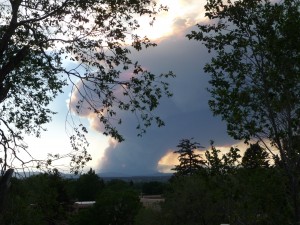
Las Conchas Fire, June 26
Sunday evening I stood on the second-story portal of my house in Santa Fe and looked west toward Los Alamos where smoke billowed like a mushroom cloud from the Las Conchas fire. Hours later in the darkness, the glow of the flames was so bright it looked as though the sun had got stuck on its way below the horizon. I remembered the Cerro Grande fire, 11 years ago, and something I wrote for the Week in Review of the New York Times: Chaos Theory; Harness Fire? Mother Nature Begs to Differ. Reading it again after all these years, I see that my theme was the illusion of control.
Las Conchas, where the fire is said to have begun — the specifics have been maddeningly imprecise — is near the trailhead for the East Fork of the Jemez River, a cool, shady meadowland where two friends and I had gone hiking just the week before. We had planned to hike that day to Nambe Lake in the Sangre de Cristo mountains on the opposite side of Santa Fe. But the forest there had just been closed because another fire, called the Pacheco because it was mistakenly reported to have begun in Pacheco Canyon, was burning out of control. I can see its plume from the east side of my house. I feel surrounded.
Late in the afternoon the smoke from both fires filters the light and gives everything an eerie orange cast. Doomsday, it seems, would look like this. I try not to imagine what is happening now to so many of my favorite places: The high meadows of Rancho Viejo where the Rio Capulin flows on its way to meet the Nambe. The Upper Crossing of Frijoles Canyon, one of the only places in New Mexico where I’ve seen fireflies at night. All of that appears to be burning and there is nothing I, or really anyone, can do about it.
A neighbor, fearing fallout from the fire near Los Alamos, is flying with her child to Denver and what she feels instintively is safer ground. The odds of a radioactive release appear to be vanishingly small. It is probably more likely, God forbid, that her plane would crash. As with Cerro Grande the great threat is not from a nuclear reaction but a chemical one: oxidation. It starts as an innocent spark. Fueled by the trees we love and the air we breath it consumes mountainsides and memories.
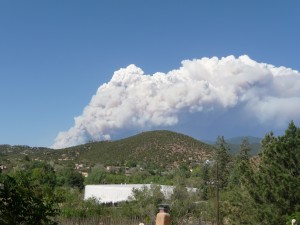
Pacheco Fire, June 25
George Johnson
The Santa Fe Review




